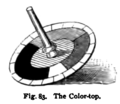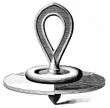Top


A spinning top is a toy designed to spin rapidly on the ground, the motion of which causes it to remain precisely balanced on its tip because of its rotational inertia. Such toys have existed since antiquity. Traditionally tops were constructed of wood, sometimes with an iron tip, and would be set in motion by aid of a string or rope coiled around its axis which, when pulled quickly, caused a rapid unwinding that would set the top in motion. Today they are often built of plastic, and modern materials and manufacturing processes allow tops to be constructed with such precise balance that they can be set in motion by a simple twist of the fingers and twirl of the wrist without need for string or rope.
Characteristics

The motion of a top is produced in the most simple forms by twirling the stem using the fingers. More sophisticated tops are spun by holding the axis firmly while pulling a string or twisting a stick or pushing an auger. In the kinds with an auger, an internal weight rotates, producing an overall circular motion. Some tops can be thrown, while firmly grasping a string that had been tightly wound around the stem, and the centrifugal force generated by the unwinding motion of the string will set them spinning upon touching ground.
The top is one of the oldest recognizable toys found on archaeological sites. Spinning tops originated independently in cultures all over the world.[2] Besides toys, tops have also historically been used for gambling and prophecy. Some role-playing games use tops to augment dice in generating randomized results; it is in this case referred to as a spinner. A thumbtack may also be made to spin on the same principles.
The action of a top is described by equations of rigid body dynamics (see the section Rotation in three dimensions). Typically the top will at first wobble until the shape of the tip and its interaction with the surface force it upright. After spinning upright for an extended period, the angular momentum will gradually lessen, leading to ever increasing precession, finally causing the top to topple in a frequently violent last thrash.
There have been many developments within the technology of the top. Bearing tops, with a tip that spins, have been one of the biggest changes. In addition, plastic and metal have largely supplanted the use of wood in tops. Fixed tip tops are featured in National Championships in Chico, California and in the World Championships in Orlando, Florida.
A top may also be used to demonstrate visual properties, such as by James David Forbes and James Clerk Maxwell in Maxwell's disc (see color triangle). By rapidly spinning the top, Forbes created the illusion of a single color that was a mixture of the primaries:[3]
[The] experiments of Professor J. D. Forbes, which I witnessed in 1849… [established] that blue and yellow do not make green, but a pinkish tint, when neither prevails in the combination…[and the] result of mixing yellow and blue was, I believe, not previously known.— James Clerk Maxwell, Experiments on colour, as perceived by the eye, with remarks on colour-blindness (1855), Transactions of the Royal Society of Edinburgh
Maxwell took this a step further by using a circular scale around the rim with which to measure the ratios of the primaries, choosing vermilion (V), emerald (EG), and ultramarine (U).[4]
Asymmetric tops of virtually any shape can also be created and designed to balance.[5]
Notable types
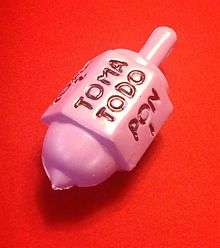

- Competing tops
- Teetotum
- Dreidel
- Gaming top
- Levitating top
- Perinola, a six-sided top, very similar to the dreidel, that is used for a similar game in Latin America[6]
- Rattleback or celt, a top that reverses its spin direction
- Tippe top
- Trompo, Whipping top
- Wizzzer
- Gasing is the Malay term for a spinning top and is a popular sport. Some tops can spin for hours.[7][8]
Beigoma
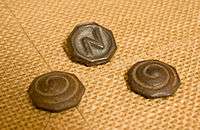

Beigoma are traditional Japanese spinning top toys.
A small but light pointy shaped toy of approximately 3 cm in diameter, it is spun by wrapping a thin 60 cm cord around it, then throwing it while releasing the cord to spin it onto a surface such as matting spread across the top of a barrel. The thrower aims it at another beigoma that is already spinning to knock it out of the playing area. The loser is the player whose top either stops spinning first or is knocked outside the area. If spun correctly it makes a humming sound.
They are often decorated with kanji, for example with names of famous baseball players.[9][10][11]
Beigoma may have come to Japan from China, originating as Koma (wooden toys), popular with ordinary people in the Kamakura period. The toy was well known in the 17th century Edo period and was originally made by filling spiral seashells with sand and sealing them with molten wax. By the 20th century, they were made of lead and later, cast metal. Their popularity peaked in the first half of the 20th century, losing favour as newer post war toys became available. Recently, the popular Beyblade toy, which is modelled after beigoma has caused a re-surge in interest. Beyblades are similar to beigoma but have no stem.[12][13][14][15]
In 2001 there was only one factory still making them, in Kawaguchi, Saitama prefecture.[10][11][12]
In popular culture
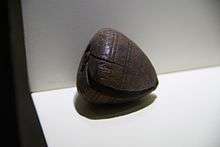
The Jean Shepherd story, "Scut Farkas and the Murderous Mariah" revolves around top-spinning in the fictional Depression-era American city of Hohman, Indiana. The bully and the named top in the title are challenged by Shepherd's ongoing protagonist Ralph and a so-called "gypsy top" of similar design to Mariah named Wolf.[16]
See also
- Bauernroulette
- Diabolo
- Gee-haw whammy diddle
- Yo-yo
- ForeverSpin
- Spindle (textiles)
- Lagrange, Euler, and Kovalevskaya tops
References
- ↑ "Gyro-top to stop: Maker closing shop". The Japan News. February 22, 2015.
- ↑ D. W. Gould (1973). The Top. NY: Clarkson Potter. ISBN 0-517-50416-2.
- ↑ Peter Michael Harman (1998). The Natural Philosophy of James Clerk Maxwell. Cambridge University Press. ISBN 0-521-00585-X.
- ↑ James Clerk Maxwell (2003). The Scientific Papers of James Clerk Maxwell. Dover Publications. ISBN 0-486-49560-4.
- ↑ Bächer, Moritz; Whiting, Emily; Bickel, Bernd; Sorkine-Hornung, Olga (August 10–14, 2014). "Spin-It: Optimizing Moment of Inertia for Spinnable Objects" (PDF). ACM Conference on Computer Graphics & Interactive Techniques (SIGGRAPH) 2014. Retrieved 15 August 2014.
- ↑ National Recreation Association (1965). Recreation. p. 92.
- ↑ http://traditionalgamescct.blogspot.ch/2013/03/gasing.html
- ↑ http://eresources.nlb.gov.sg/infopedia/articles/SIP_401_2004-12-09.html
- ↑ Mahoney, Tracy. "Toy Box". Archived from the original on 2007-08-07. Retrieved 2008-04-07.
- 1 2 "What's cool in Japan:Beyblades". June 2001. Archived from the original on 10 April 2008. Retrieved 2008-04-07.
- 1 2 Satoshi, Matsuoka (2001-12-15). "Trends Today". Nipponia. Web Japan. Archived from the original on 10 April 2008. Retrieved 2008-04-07.
- 1 2 "Traditional Games Making a Comeback". The Japan Forum. Retrieved 2008-04-07.
- ↑ "Tell Me Why". The Times India. ABP Pvt. Limited. 2005-12-29. Retrieved 2008-04-07.
- ↑ Townley, Piers (2002-01-25). "Gadgets and Gizmos:Spin Dizzy; On A Whirlwind Trip From Japan". Daily Record. Scottish Daily Record and Sunday Mail Ltd. Retrieved 2008-04-07.
- ↑ "Beyblade Beta History". Retrieved 2008-04-07.
- ↑ Shepherd, Jean. "Scut Farkas and the Murderous Mariah," Wanda Hickey's Night of Golden Memories and Other Disasters (New York: Doubleday Dolphin Books), 1976 ISBN 0-385-11632-2
Further reading
| Wikimedia Commons has media related to Spinning top. |
| Wikisource has the text of the 1911 Encyclopædia Britannica article Top. |
- Crabtree, H. "An Elementary Treatment of the Theory of Spinning Tops and Gyroscopic Motion". Longman, Green and C), 1909. Reprinted by Michigan Historical Reprint Series.
- Perry J. "Spinning Tops". London Society for Promoting Christian Knowledge, 1870. Reprinted by Project Gutemberg ebook, 2010.
- Provatidis, Christopher, G. (2012). Revisiting the Spinning Top, International Journal of Materials and Mechanical Engineering, Vol. 1, No. 4, pp. 71–88, open access at http://www.ijm-me.org/Download.aspx?ID=2316 (ISSN Online: 2164-280X, ISSN Print: 2162-0695)
- A forum discussing all things related to the art of Top Spinning: iTopSpin.com
-
 "Top". The New Student's Reference Work. 1914.
"Top". The New Student's Reference Work. 1914.
